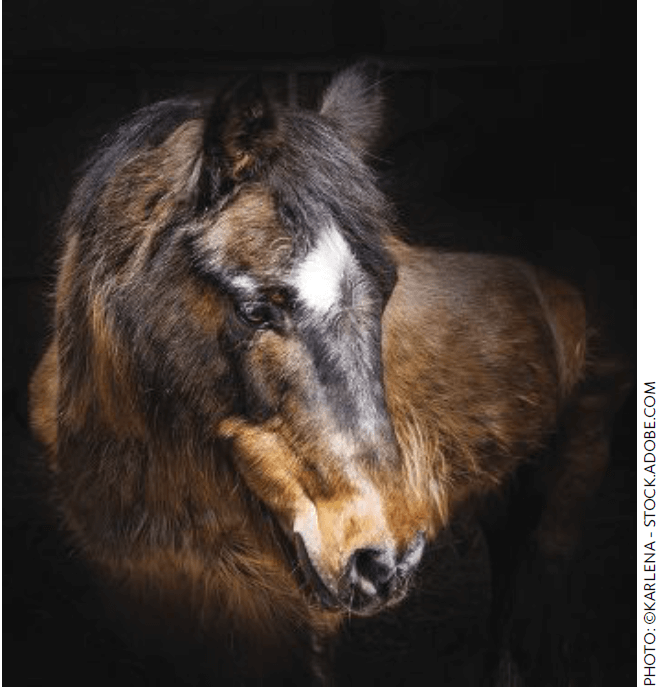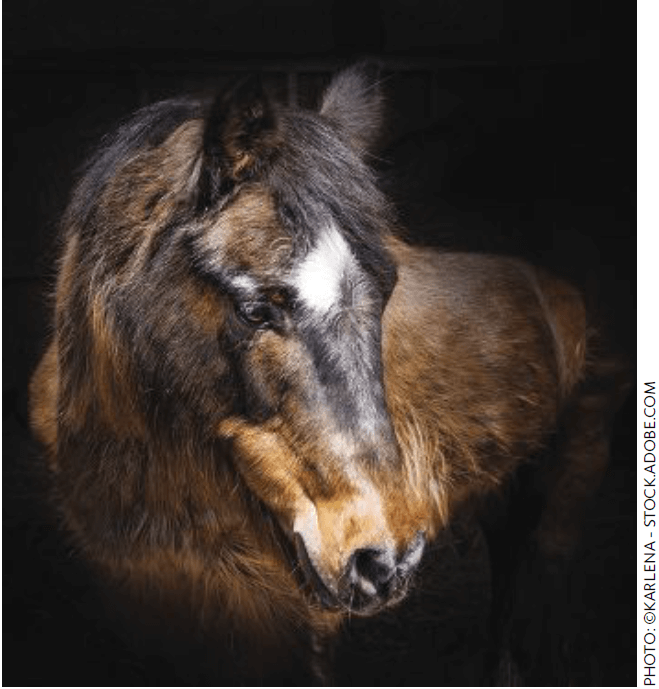Early Diagnosis and Treatment Prolongs Life and Reduces Symptoms
By Viveka Rannala DVM
 Most horse owners are aware of Cushing’s disease, known in the veterinary community as Pars Pituitary Intermedia Dysfunction (PPID). The well-known sign of PPID is a long, curly coat seen on a thin, elderly horse. However, many owners are shocked to learn that signs of PPID can be much more subtle.
Most horse owners are aware of Cushing’s disease, known in the veterinary community as Pars Pituitary Intermedia Dysfunction (PPID). The well-known sign of PPID is a long, curly coat seen on a thin, elderly horse. However, many owners are shocked to learn that signs of PPID can be much more subtle.
By the time a horse has grown a long, curly coat, the disease is often in an advanced stage. With proper testing and a knowledge of subclinical signs, we can frequently diagnose the disease before that time, thus potentially avoiding serious side effects. In general, PPID develops in horses in the late teens and beyond, but it has been diagnosed in younger horses as well.
So, what is PPID? PPID is the result of the enlargement of the pars intermedia – the middle portion of a small gland at the base of the brain that secretes hormones into the bloodstream. In horses with PPID, the pars intermedia becomes overactive and secretes an excess of several hormones that affect different parts of the body. Unnaturally high levels of these hormones contribute to the varied clinical signs of PPID.
Clinical signs that make us suspicious of PPID include:
- Excessive hair growth
- Failure to shed appropriately
- Loss of topline
- Laminitis/recurrent foot abscesses
- Lethargy
- Exercise intolerance
- Infertility
- Excessive sweating
- Delayed wound healing
- Increased susceptibility to infection
- Increased drinking and urination
- Altered mental activity
Diagnosis
One of the hormones produced in excess is adrenocorticotropic hormone (ACTH), which can be measured in the blood. PPID is confirmed if ACTH levels are above a certain threshold.
This threshold changes during the fall months as ACTH levels are naturally high, even in healthy horses. Some horses have normal ACTH levels, but are still afflicted with PPID.
If your horse has clinical signs suspicious of PPID, but their ACTH levels are normal, your veterinarian can perform an additional test. This test involves injection of thyrotropin-releasing hormone (TRH) into the bloodstream and measuring the changes in ACTH level. In horses with PPID, there is an abnormal rise in the ACTH. This test is more sensitive than resting ACTH but can only be performed at certain times of the year because there are no current reference ranges to account for the natural rise of ACTH levels in the fall.
Treatment
Once PPID has been diagnosed, the next step is treatment. There is no cure for PPID, but most horses can be managed successfully with a combination of medication and lifestyle changes. The goal is to slow the progression of PPID, reduce the chances of serious side effects, and prolong the patient’s life.
The medication of choice is called pergolide, which helps the body reduce hormone secretion from the pars intermedia. Often within as little as 30 days of treatment owners will notice a significant improvement in clinical signs. Re-testing is recommended to monitor the efficacy of treatment and to help determine if adjustments in medication need to be made as the dose may change over time. In some cases, it may be necessary to use other medications in conjunction with pergolide, especially as your horse ages and the disease progresses.
In addition to medication, preventative health care is important for these horses as PPID suppresses the immune system. This care should include:
- Frequent hoof care (especially for those with a history of laminitis)
- Regular dental care
- Parasite prevention
- Diet management
- Appropriate vaccinations
- Body clipping (especially for those with delayed shedding and/or excessive sweating)
Your veterinarian will often recommend a controlled low sugar, low starch diet, especially in horses that have laminitis. Horses with PPID may also have trouble controlling their insulin – the hormone that controls blood sugar.
Hay that is low in sugar and starches can be difficult to find in the Pacific Northwest, but owners can send hay for testing to determine its sugar content. Due to high demand, hay suppliers often test their hay prior to selling it.
Soaking hay before feeding can reduce sugar content, but it’s important to note that results vary. It’s also important to keep treats that are high in sugar to a minimum, including carrots and apples.
PPID is a common disease, especially in older horses, but early diagnosis can help minimize the effects. Talk to your veterinarian if you are concerned that your horse may have PPID or need help managing PPID in your horse. Our goal is to keep your equine companions healthy and happy!

The Northwest Horse Source is an independently owned and operated print and online magazine for horse owners and enthusiasts of all breeds and disciplines in the Pacific Northwest. Our contemporary editorial columns are predominantly written by experts in the region, covering the care, training, keeping and enjoyment of horses, with an eye to the specific concerns in our region.






